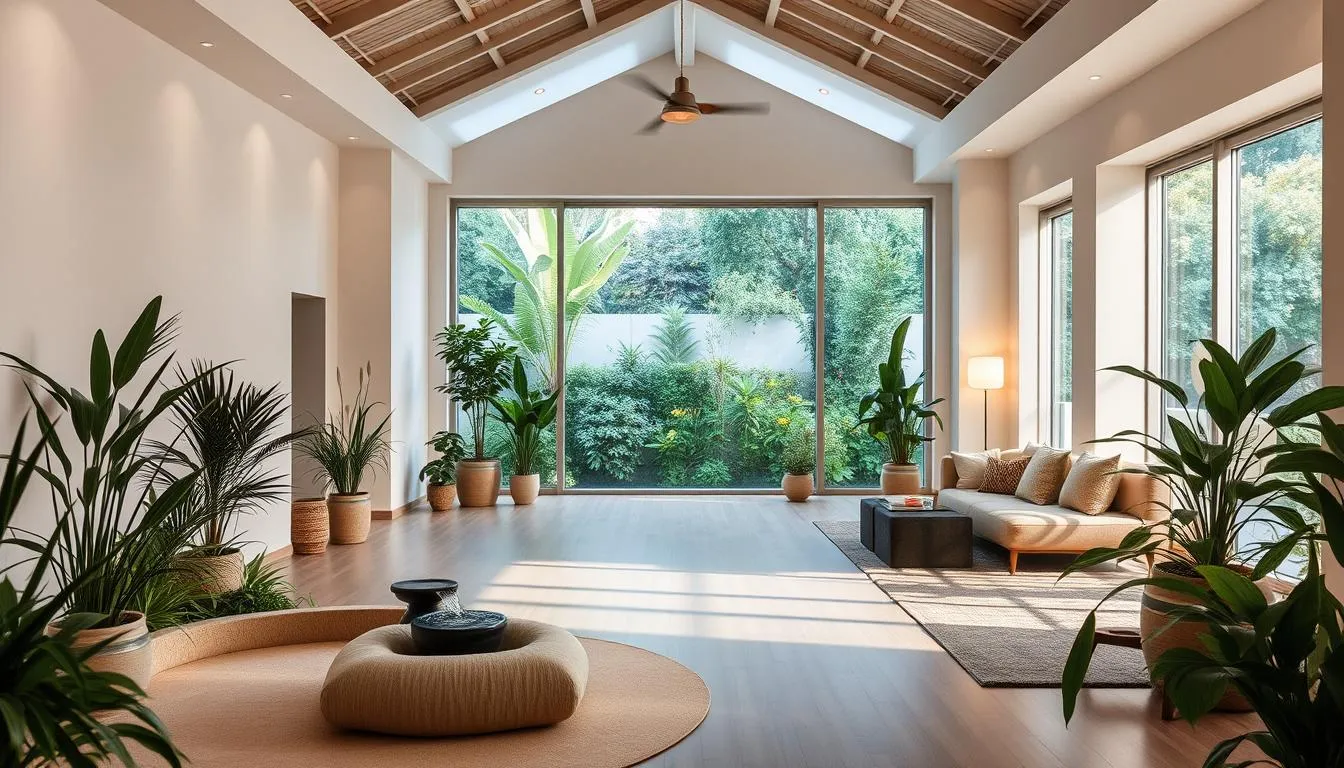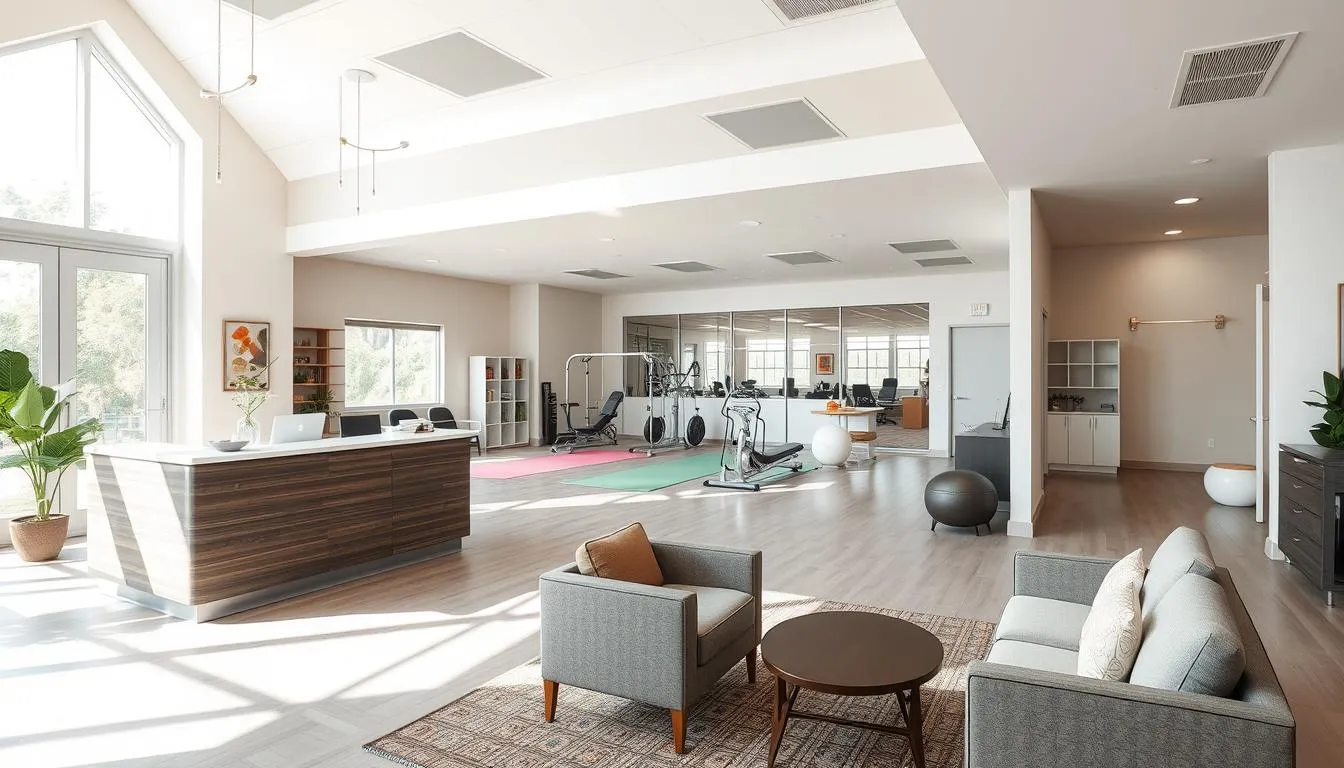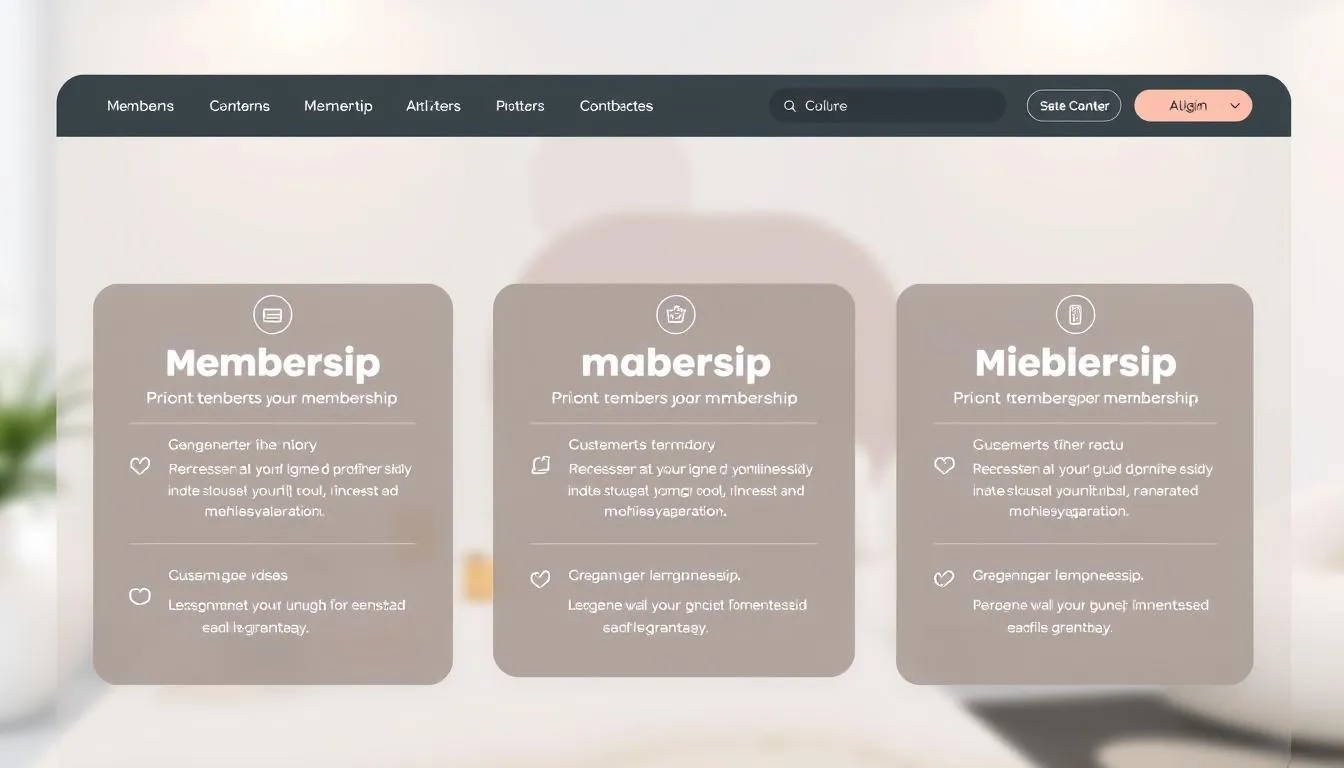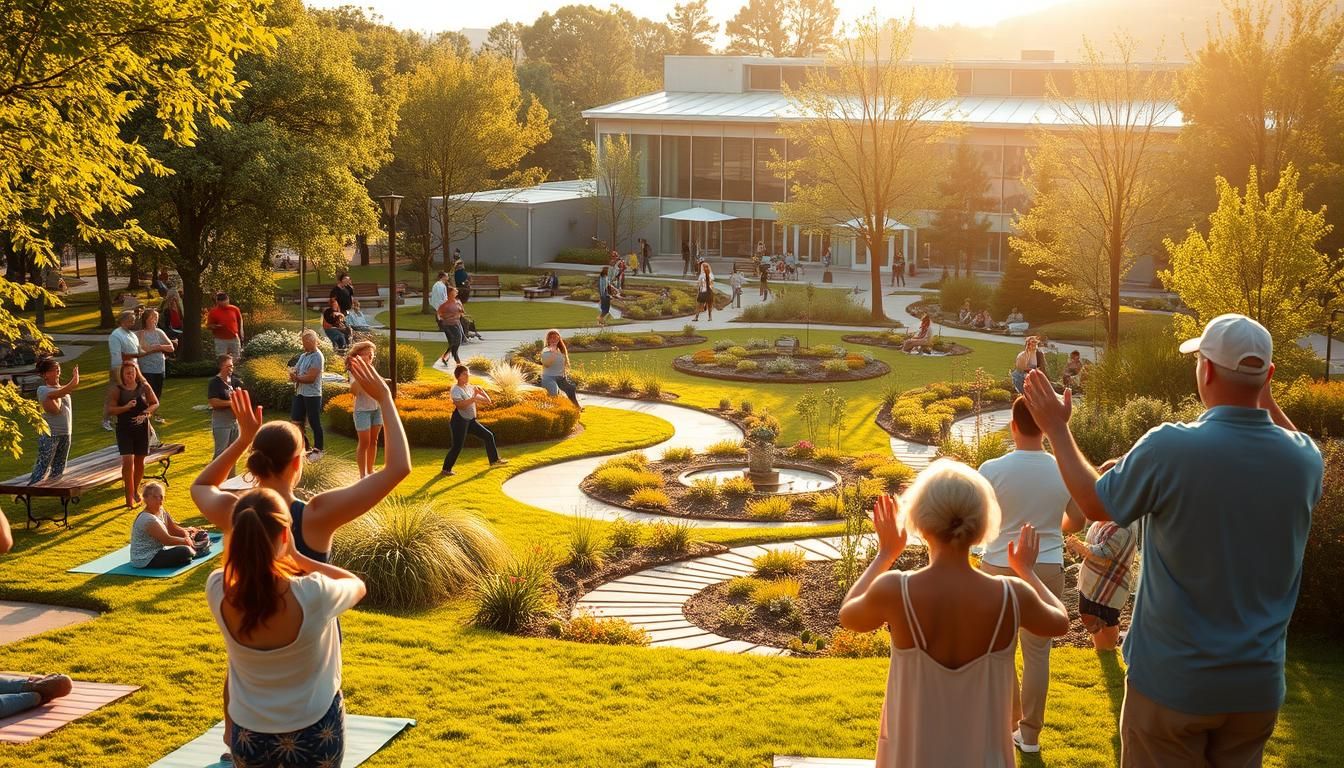Some days work feels heavy, and what you need is a place that lifts you. I remember hunting for spots where I could get real focus, take a quick stretch, or join a gentle yoga break between calls. That search changed how I plan my days.
Wellness coworking is growing fast and now offers standing desks, HEPA filters, healthy snacks, yoga, saunas, and cold plunges. Big names like The Well, KoWorks, Wello Works, and This Human Thing show how design and services can support how you work and live.
This short guide helps you map nearby options, compare membership choices, and spot the must-have features for your needs. You’ll learn what to check about hours, booking rules, and events that spark real connection.
Practical steps and clear checklists follow so you can shortlist places that match your routine—whether you want quiet focus, light movement breaks, or restorative moments.
Key Takeaways
- Wellness-driven locations blend work and restorative features to boost daily productivity.
- Use this guide to match your needs with nearby municipal centers and coworking space models.
- Check amenities, access, and membership terms before shortlisting options.
- The booming wellness market means more local choices with thoughtful features.
- Look for events and member culture to prioritize authentic connection alongside personal goals.
How this How‑To Guide helps you find wellness and connection in your area
This guide uses a simple, stepwise approach so you can match nearby offerings to your daily routine and personal wellness priorities.
Start with quick filters: pick your top needs, then scan listings for coworking spaces, municipal centers, and local resources that meet those items. The checklist highlights green flags and common red flags to avoid trial‑and‑error visits.
We show how to weigh amenities and services against real benefits — better mood, clearer focus, and steadier work‑life balance. You’ll get tips to compare layouts for quiet focus versus social collaboration.
Look for easy signs of inclusivity, member vibe, and staff support without touring every option. The guide also points to where transparent pricing, booking rules, and add‑ons appear on websites so you can skip surprises.
- Contrast events, workshops, and meetups to find suitable opportunities for connection.
- Prioritize must‑haves vs nice‑to‑haves to keep the search focused and fast.
Quick start: A simple path to discovering spaces that fit your health goals
Begin with one clear question: what do you need from a visit — mental support, light fitness, or broader wellness care?
Define your needs: mental support, fitness, or holistic care
Write a short list of priorities. Keep it to three must-haves so you can filter options fast.
Examples: quiet work rooms, counseling access, yoga classes, or exam rooms that may include clinical services.
Map nearby options: coworking, municipal centers, medical coworking
Sketch a search radius by area and neighboring areas to set realistic travel time for a typical day.
Check each listing for included amenities and add-on services. Confirm access, parking, transit, and safe bike routes.

| Type | Typical amenities | Best for | Quick check |
|---|---|---|---|
| Wellness coworking | HEPA filters, standing desks, snacks | Daily work + light movement | Hours, day passes, class schedule |
| Municipal centers | Programming, green-space access, FAQs | Public programs and workshops | Project updates, booking rules |
| Medical coworking | Exam rooms, admin support | Clinical visits and procedures | Privacy, licensing, reservation policy |
- Pick 3–5 options and request trial visits or day passes.
- Use a simple scorecard: vibe, amenities, services, commute, and community fit.
Understanding the types of health‑focused community spaces
Spaces that mix productivity and wellbeing come in three main flavors; learning their differences saves time on tours.
Wellness coworking spaces are hybrids for work and restoration. They pair desks with HEPA air, standing desks, healthy snacks, yoga classes, saunas, and cold plunges. The Well helped popularize this premium model.
These coworking spaces suit people who want regular balance during the day. Layouts trend social but include quiet rooms for focus.
Municipal community health and wellness centers offer public programs, open gyms, walking tracks, and green‑space access. They post FAQs about parking, hours, and timelines.
These centers often provide an affordable way to join classes or local events. The vibe is neighborhood oriented and program-driven.
Medical coworking spaces support doctors, nurses, therapists, and other professionals with private offices, exam rooms, procedure rooms, reception, and admin support.
This coworking space model prioritizes privacy and clinical workflows. It reduces overhead while giving flexible access to professional rooms.
- Mental health support appears across types — from mindfulness rooms to counseling services.
- Pick wellness coworking for daily balance, municipal centers for affordable programs, and medical coworking for clinical needs.
Health‑oriented services and amenities to look for
Focus on amenities that support work flow, then note add-ons for deeper restoration.
Included essentials: Look for HEPA air filtration, standing desks, filtered water, air‑filtering plants, soft soundtracks, and nourishing snacks. These amenities keep your day steady and comfort simple.
Add‑on services: Check whether the venue offers yoga and fitness classes, massage therapy, infrared saunas, or cold plunges. These services may include scheduled sessions or bookable treatments for recovery.
Mental health resources: Prioritize quiet rooms, counseling availability, and mindfulness programming. Spaces with clear sign‑posting that separates free amenities from paid offerings help members avoid surprises.

| Category | Common features | What to confirm |
|---|---|---|
| Daily amenities | HEPA filters, standing desks, filtered water, snacks | Included in membership or day pass? |
| Recovery add‑ons | Yoga, fitness classes, sauna, cold plunge, massage | Booking rules, extra fees, class schedule |
| Mental wellness | Quiet rooms, counseling, guided breathing | Privacy, booking, staff support |
- Walk the space to test acoustics and comfort.
- Ask staff about maintenance and how often features are refreshed.
- Compare places by must‑have features, not just the longest list of amenities.
- Note models like KoWorks, which pair free breathing classes with bookable treatments for deeper wellness.
Assessing access, hours, and rooms before you visit
A quick check of entry, hours, and booking systems saves time and reduces surprises on your first visit. Use this short plan to confirm logistics and room availability so your visit supports your work rhythm.
Open hours, peak times, and booking policies
Check posted hours and ask about peak times so visits match your focus windows. Many operators publish schedules and FAQs online, while municipal sites list parking and green‑area access.
Confirm booking rules: can members reserve same‑day? Do benefits include guest passes or extended hours? Mobile booking apps often handle rooms and wellness resources.
Meeting rooms, meditation rooms, and private offices availability
Review which rooms are bookable and whether time limits may include quiet‑hour rules. Medical coworking may include dedicated exam or procedure rooms with cadence-based scheduling and admin support.
Evaluate noise and zones for deep work, calls, or decompression. Ask staff about typical busy periods and make a short checklist: access ease, booking clarity, room comfort, and staff support.
- Confirm transit, parking, and bike storage before a first visit.
- Test the booking portal or app to reserve rooms and resources.
- Compare places quickly by the clarity of rules and ease of entry.
Budgeting and membership options that match your usage
Start by matching your weekly routine to pricing tiers so you don’t overpay for unused perks. That simple step makes it easier to pick the right plan.
Day passes vs. memberships: choosing the right service option
Compare how often you will use a site. A day pass suits occasional visits. A recurring membership saves money if you go several times a week.
Tip: Tally typical days per month and divide the membership cost to spot true value.

Add-on revenue features: classes, events, and resource bookings
Wellness coworking models mix included perks with paid add-ons. Classes, saunas, massages, and special events generate extra revenue for operators.
Ask how bookings and bundles work. Credits or class packs often lower per-item costs for frequent users.
Virtual office and part‑time memberships for flexible needs
Virtual office and part‑time plans suit freelancers, clinicians, or small business owners who need mail handling and occasional room access.
Confirm access to private offices or exam rooms before upgrading. Check freeze, cancellation, and upgrade terms to protect your budget and long‑term success.
“This small budgeting check will help members choose options that match real routines rather than idealized use.”
| Plan | Best for | What to confirm |
|---|---|---|
| Day pass | Occasional visits | Included services, peak hours |
| Recurring membership | Regular users | Hours, add-ons, freeze policy |
| Virtual / part‑time | Mail/occasional access | Mail handling, room credits |
- Compare total monthly cost by adding expected add‑ons to base price.
- Look for promotions or trial offers to test a space affordably.
- Weigh premium environment and staff support against the price for long‑term consistency.
Where to search in the United States: local market tactics that work
Local sources often reveal openings and rules before broader listings do. Start with city project pages and neighborhood portals to spot timelines, council updates, and newly posted frequently asked questions. These pages often mention parking, access to green space, and site selection notes.
Use three practical channels:
City sites and community pages for project updates and FAQs
City sites list milestones like 2025 design development and construction schedules. Sign up for project alerts or newsletters so you get notices about open houses and membership windows.
Directories and coworking platforms to filter for wellness features
Search coworking spaces directories that let you filter by features such as meditation rooms, saunas, and on-site yoga. Filter results by neighborhood areas to compare commute time and nearby parks.
“Track a small shortlist and visit during an open house — seeing a place once often answers more questions than a long search online.”
| Where to look | What to check | Why it matters | Next step |
|---|---|---|---|
| City project pages | Timelines, FAQs, parking and access | Shows openings and policy changes | Subscribe to project alerts |
| Coworking directories | Filterable amenities and events | Find places with specific features | Save 3–5 matches |
| Social reviews & local groups | User posts, staff response times | Reveals real vibe and reliability | Plan a trial visit or open house |
- Compare neighborhood areas for safety, transit, and bike routes.
- Read frequently asked questions to confirm rules about access and parking.
- Track contact info in a simple spreadsheet to act when openings appear.
Evaluating community, events, and connection opportunities
Look for how social programming and member mix create real opportunities to meet like‑minded people. A good calendar turns a visit into ongoing benefit.
Wellness events, workshops, and meetups that build connection
Review the programming calendar for workshops, wellness events, and member‑led meetups that match your interests.
Variety matters: talks, breathwork, yoga, and walking groups let you mix learning, movement, and recovery.
Check whether events are free for members or ticketed. Priority access for members adds clear benefits.
Member mix and values: finding like‑minded individuals
Ask how new members are welcomed and introduced to others. Immediate intros, as KoWorks practices, speed comfort and belonging.
Evaluate the member mix — founders, remote workers, creatives, and clinicians — to see if it matches your goals.
- Confirm event notices arrive via app, newsletter, or community board so you don’t miss opportunities.
- Look for mental health supports: quiet nooks, mindfulness rooms, or counseling access.
- Attend at least one gathering during a trial to gauge warmth and shared values.
- Make sure the space layout supports both social zones and private nooks for flexible social bandwidth.
“Thoughtful programming and fast introductions turn single visits into steady routines.”
health‑focused community spaces: how operators design for success
The smartest operators treat wellness as a value stack that earns loyalty and justifies price. They sell reliable access first, then layer curated programs and premium treatments to raise perceived value.
Business model basics: services, amenities, and additional revenue
Core offering: desks, meeting rooms, and private offices form the base of the business model.
Operators add routine programming and light perks to keep members coming back. Paid add-ons — saunas, cold plunges, massage — create incremental revenue while meeting daily needs.
Clear bundles and day passes reduce friction and make pricing easy to compare.
Differentiators that matter: premium wellness features and trends
Premium features that actually get used justify higher pricing. Invest in HEPA air, standing desks, locker service, and fast booking tools for professionals.
Publish transparent value stacks so members know what’s included and what costs extra. Measure utilization and feedback, then reallocate budget toward the most‑loved resources.
“Standout operators pair excellent wellness features with warm hospitality and simple systems.”
- Right‑size amenities, not everything at once.
- Prioritize retention with clear positioning and seamless resources.
Technology and booking tools that streamline your experience
Smart booking tools remove friction so you spend time working, not scheduling. Good tech makes it simple to reserve a room, sign up for a class, or grab a last-minute slot for recovery.
Key benefits: faster planning, clear pricing, and fewer surprises. Operators use platforms to promote wellness products and enable mobile bookings for yoga or meditation. Optix supports many wellness coworking operations, while Spacebring adds clinical scheduling and utilization tools for medical users.
Mobile bookings for classes, rooms, and wellness resources
Choose a site that offers mobile booking so you can reserve rooms or resources in seconds. Look for app features like waitlists, reminders, and calendar sync.
Notifications for openings and reminders help you slot short wellness breaks between meetings. Clear service pricing inside the app prevents unexpected charges.
Coworking software that connects members and manages access
Good coworking software keeps members linked through directories, messaging, and event RSVPs.
- Confirm digital access: mobile keys, guest passes, and after-hours permissions.
- For professionals, verify clinical scheduling, privacy controls, and reliable room turnover.
- Favor tools that integrate with calendars and payments to reduce admin time.
- Ensure fast staff support when bookings or access hiccups occur.
“Technology should free your day—fast bookings, clear access, and staff that back the app.”
Future‑focused trends shaping the local market
Local trends now favor hybrid venues that let you work, move, and recover without changing neighborhoods.
Growth in wellness coworking will continue as the global wellness market expands. Operators add restorative amenities and flexible desks to attract regular users. Expect more hybrid layouts with open collaboration zones and small private offices for deep work.
Rise of medical coworking and telehealth rooms is driven by workforce shifts and tech adoption. By 2030, the expanding care workforce will increase demand for clinical-ready rooms and admin support. Professionals want bookable rooms with great acoustics, high-speed internet, and privacy.
“Telehealth-ready rooms and smart booking reduce friction and let practitioners serve patients from flexible locations.”
- Watch for local market differentiation: some neighborhoods favor movement and green access; others emphasize clinical services.
- Member feedback will steer programming toward breathwork, strength, or mental resources.
- Tech will simplify bookings, cut no-shows, and boost utilization.
Real‑world inspiration: what to learn from standout spaces
Study standout operators to see which design choices and programs actually deliver value.
Wellness coworking examples: Look at KoWorks for an elegant value stack — free breathwork and meditation plus bookable saunas, yoga, and cold plunges. Wello Works mixes infrared saunas, meditation pods, and LED light therapy alongside desks for short recovery between calls. This Human Thing centers therapists with regular mindfulness events and peer learning.
Translate those ideas into a short checklist: which amenities, rooms, and services support your daily rhythm? Which private offices or exam rooms do professionals need?
Municipal centers and medical coworking
Follow city project pages for timelines, open houses, and newly posted frequently asked questions about parking and access to green space in your area.
For medical use, prioritize exam/procedure rooms, admin resources, scheduling support, and networking areas. Attend events and talks to test whether the place feels welcoming and well‑maintained. Capture what works and adapt those elements to your shortlist.
“See how operators pair included perks with bookable upgrades; copy what fits your day.”
- Note which amenities drive daily use.
- Check access rules and event calendars before you visit.
- Prioritize rooms and services that match your work and recovery needs.
Conclusion
, Aim for one reliable spot that fits your schedule and supports short reset moments. Use this practical approach to match your top needs and test places with a day pass or trial visit.
Prioritize fit by mapping your routine, checking hours and bookings, and sampling core services. Note the energy and event flow so you can tell which venue suits your work and downtime.
Compare membership value, track municipal updates and directories for new opportunities, and weigh business tradeoffs—higher quality often brings steadier results. Keep your shortlist flexible as your needs change.
Ask questions, watch staff hospitality, and trust what you feel on visits. When a place helps you do your best, lean in: engage with the community, try offerings, and let the environment lift your daily routine.
FAQ
How do I start finding health-focused community spaces near me?
Begin by defining what you need—mental health support, fitness classes, or holistic services. Use local city websites, community calendars, and directories like Mindbody or Peerspace to filter for wellness amenities and private offices. Visit listings, check hours and booking policies, then schedule a tour to confirm the vibe and resources.
What amenities should I prioritize when touring a space?
Look for HEPA filtration, standing desks, filtered water, and healthy snack options. Also confirm availability of meeting rooms, meditation or mindfulness rooms, and private exam rooms if you need medical coworking. These features support comfort, productivity, and safety.
How do day passes compare to memberships?
Day passes work well for occasional visits or testing a space. Memberships save money for regular users and often include perks like discounted classes, free bookings, or priority access to private rooms. Evaluate your weekly usage to choose the smarter option.
Can I find medical coworking with exam rooms and professional services?
Yes. Medical coworking spaces offer private offices, exam rooms, and credentialed support for clinicians. Search specialized directories, contact operators directly about credentialing and liability coverage, and confirm telehealth-ready rooms if you need virtual appointments.
What booking tools help manage classes and rooms?
Look for spaces that use mobile-friendly coworking software—examples include Cobot, Nexudus, and Mindbody. These platforms let you reserve rooms, sign up for fitness classes, and manage billing from your phone.
How do I assess community and events before joining?
Review the events calendar and member testimonials, attend a meetup or workshop, and ask about the member mix. Strong operators run regular wellness events, workshops, and meetups that foster connection and collaboration among like-minded professionals.
What should small businesses or solo practitioners know about revenue opportunities?
Operators often generate add-on revenue from classes, massage, saunas, and resource bookings. If you run services, ask about renting treatment rooms, hosting paid workshops, or listing offerings through the space’s booking system to reach members.
Are there flexible membership options for part‑time use or virtual offices?
Yes. Many spaces offer virtual office plans, part‑time memberships, and credits for room bookings. These options suit freelancers, therapists, and clinicians who need occasional physical rooms plus mailing address or reception services.
How do I check access, safety, and peak times before visiting?
Ask the operator about building access, security measures, peak hours, and cleaning protocols. Request data on typical occupancy and whether the space enforces booking windows for popular rooms to avoid conflicts.
Where can I search for wellness-focused coworking in the United States?
Use local government pages, neighborhood forums, and coworking directories like Coworker or LiquidSpace. Filter listings for wellness features, read recent reviews, and follow city project updates for new municipal centers and green-space initiatives.
What differentiates premium wellness features from standard offerings?
Premium features include saunas, cold plunges, on-site massage, advanced air purification, and dedicated mindfulness rooms. These differentiators attract members willing to pay higher membership fees and support a spa-like ecosystem within a work environment.
How do operators design for success in this market?
Successful operators mix memberships, day passes, and add-on services. They diversify revenue with classes and events, invest in booking software, and curate member programming that aligns with local needs and professional demographics.
What trends should I watch for in the next few years?
Expect growth in hybrid wellness coworking, expansion of medical coworking with telehealth-ready rooms, and integration of advanced booking tools. Spaces will increasingly offer specialized rooms and partnerships with local practitioners to meet demand.
